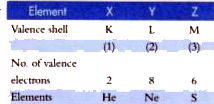The number of valence electrons in the valece shells , 1 , 2 , 3 of the X , Y , Z elements are 2 , 8 , 6 respectively . Identify the element which doesn ' t exist monoatomic state.
X
Z
Y
X and Y
The correct Answer is:b

Sulphur does not exist in monoatomic state due to its greater chemical reactivity.
Similar Questions
Knowledge Check
- Question 1 - Select One
The number of valence electrons in the valece shells , 1 , 2 , 3 of the X , Y , Z elements are 2 , 8 , 6 respectively . Identify the element which doesn ' t exist monoatomic state.
AXBZCYDX and Y - Question 2 - Select One
The atomic numbers of the elements X, Y and Z are 2, 10 and 16, respectively. Identify the element which does not exist in monoatomic state.
AXBZCYDX and Y - Question 3 - Select One
The atomic numbers of the elements X, Y and Z are 2, 10 and 16, respectively. Identify the element which does not exist in monoatomic state.
AXBZCYDX and Y
An atom of an element has one electron in the valence shell and the two inner shells have 8 electrons each. Find the atomic number of that element.
View SolutionAn atom of an element has one electron in the valence shell and the two inner shells have 8 electrons each. Find the atomic number of that element.
View SolutionThe ratio of difference in the number of electrons between K and M shells is 3:2 for X and Y elements respectively . 'X' possesses stable electronic configuration and M is the valence shell for both X and Y. The electronic configurations of X and Y are respectively.
View SolutionThe ratio of difference in the number of electrons between K and M shells is 3:2 for X and Y elements respectively . 'X' possesses stable electronic configuration and M is the valence shell for both X and Y. The electronic configurations of X and Y are respectively.
View SolutionThe ratio of difference in the number of electrons between K and M shells is 3:2 for X and Y elements respectively . 'X' possesses stable electronic configuration and M is the valence shell for both X and Y. The electronic configurations of X and Y are respectively.
View Solution

